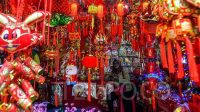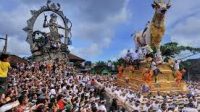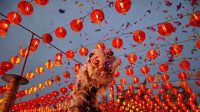KUPASONLINE.COM — New Year in Japan is a special time for food, decoration, and gathering with family. Known as Oshogatsu, a tradition of New Year celebrations in Japan.
In the Oshogatsu period, for Japanese people, they celebrate it by carrying out traditions that have existed for a long time. Here are some series of Oshogatsu traditions:
Oosoji
In Japanese culture, the new year should start with a clean slate. Not surprisingly, they carried out a massive purge otherwise known as oosoji. This usually occurs in mid-December before the new year celebrations.
The Japanese will clean their homes, offices and places of business carefully from top to bottom. This is because they believe that the god of fortune (Toshigami) will come at the beginning of the new year. Also to welcome the new year with a clean soul.
Nengajo
New Year celebrations in Japan have a custom of sending new year greeting cards or nengajo to each other. Not only intended for immediate family, but also for friends, or business associates.
The contents of the card are usually in the form of congratulating them on the new year and thanking them for something they have done in the last 12 months.
Oshogatsu kazari and kagami mochi
After the house is cleaned, it’s time to put on the decorations. Oshogatsu kazari in particular is a garnish made of straw rope, pine twigs and bamboo. And usually hung at the front door of the house with the aim of driving away evil spirits.
While other decorations are kagami mochi, Kagami Mochi is made of two round Japanese rice cakes (mochi) stacked on top of each other, where the smaller part is placed on top of the large one and then oranges and ornaments are placed on top.
Toshikoshi buckwheat
Another tradition in Japanese culture is eating certain foods, one of which is toshikoshi soba which is eaten on New Year’s Eve. Soba noodles or toshikoshi soba are eaten with the belief that eating long, thin noodles symbolizes long life, health, and strength.
Joyonokane
Joyanokane, a tradition of celebrating the New Year by ringing a large bell (kane) 108 times at Buddhist temples, begins a few minutes before the clock strikes midnight.
This is part of the most important ritual in Japan. The ringing of the bell 108 times represents their belief that humans are disturbed by 108 types of desires and worldly feelings, such as anger and jealousy. Each ringing of the bell aims to clear these worldly distractions.
Hatsuhinode
Another new year tradition is watching the first sunrise at the beginning of the year. There is something magical about watching the first sunrise of the new year. They believed that Toshigami arrived at sunrise.
Japanese people will gather on mountaintops, beaches and in other places with good views of the skyline to catch hatsuhinode and pray for good luck and happiness in the coming year.
Hatsumode
Hatsumode is a tradition with the first shrine visit of the new year. Many Japanese people go to visit the shrine on January 1-3. They come to pray, make wishes, express gratitude, and buy good luck charms. Also hope this new year brings happiness and health.
Osechi ryori
Osechi Ryori is eaten at the start of the new year. It is served in a special three to four layer bento box called a jubako which is placed in the center of the table. Each dish is meant to invite luck, prosperity and good health for the new year.
The box contains a variety of foods, such as boiled seaweed (konbu), fish cakes (kamaboko), burdock root (kinpira gobo), and sweet black beans (kuromame), each with a special meaning. For example, kuromame represents good health, something every family wishes for for the new year.
Otoshidama, Takoage, and Fukubukuro
Otoshidama is a tradition of giving envelopes filled with money to children. Money is a gift for the coming year and is often a way of showing appreciation for a child’s efforts at school the previous year.
Another fun little tradition for many people is going out and buying a fukubukuro on New Years. Fukubukuro are basically surprise bags sold at different prices, where people buy without knowing what’s inside.
While takoage, celebrating the new year by flying traditional Japanese kites.







